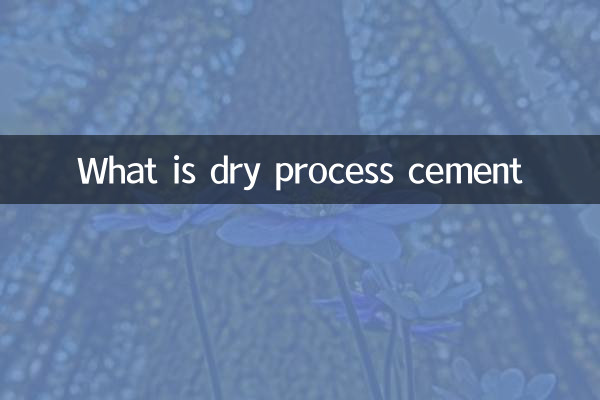What is dry process cement
Dry process cement is a process method in cement production, corresponding to wet process cement. It dries and grinds the raw materials and sends them directly to the kiln for calcination, which reduces energy and water consumption. It is one of the mainstream technologies in the modern cement industry. In recent years, with the improvement of environmental protection requirements and technological advancement, dry process cement has shown significant advantages in energy conservation and emission reduction, and has become the focus of the industry.
1. Production process of dry process cement

The production of dry process cement mainly includes four stages: raw material preparation, raw meal preparation, clinker burning and cement grinding:
| production stage | Key steps | Technical features |
|---|---|---|
| Raw material preparation | Crushing of limestone, clay and other raw materials | Use efficient crushing equipment to reduce particle size |
| Raw meal preparation | Raw material drying and grinding | Use cyclone preheater to recover waste heat |
| Clinker burning | Rotary kiln high temperature calcining | The temperature can reach 1450℃, forming mineral phase |
| cement grinding | Clinker and gypsum mixed and ground | Fineness control affects cement strength |
2. Technical advantages of dry process cement
Compared with traditional wet process, dry process cement has the following significant advantages:
| Compare items | dry process | wet process |
|---|---|---|
| energy consumption level | Reduce 30%-40% | Higher energy consumption |
| water consumption | Basically no process water required | A large amount of water is required to prepare the slurry |
| exhaust emissions | Equipped with efficient dust removal equipment | High humidity of flue gas makes treatment difficult |
| Covered area | smaller | Requires slurry pool and other facilities |
3. Latest trends in the industry (hot spots in the past 10 days)
According to recent industry information, the following important developments have been made in the field of dry process cement:
| Date | Hot content | Scope of influence |
|---|---|---|
| 2023-11-05 | Conch Cement announces new intelligent dry process production line | Anhui/Yangtze River Delta Region |
| 2023-11-08 | Ministry of Industry and Information Technology releases new version of energy consumption limit standard for cement industry | Mandatory nationwide |
| 2023-11-10 | Huaxin cement carbon capture project officially put into operation | Industry emission reduction demonstration |
| 2023-11-12 | Southeast Asian countries increase imports of dry process cement | international trade market |
4. New trends in environmental protection development
Driven by the "double carbon" goal, dry cement technology is developing in a more environmentally friendly direction:
1.alternative fuel applications: More and more companies are using refuse-derived fuel (RDF) to replace coal, which not only processes solid waste but also reduces fossil energy consumption.
2.carbon capture technology: The demonstration project has captured CO2 in the kiln tail flue gas and used it for the production of food-grade dry ice, creating a new circular economy model.
3.Intelligent control: By optimizing the calcination parameters through AI algorithms, a leading company has increased the clinker free calcium oxide qualification rate to 98.5%, significantly reducing quality waste.
5. Frequently Asked Questions
| question | Professional answers |
|---|---|
| Is dry cement less strong? | Modern processes can achieve grades of 52.5 or even 62.5 through precise mineral proportioning and grinding control |
| How to control dust pollution? | Bag dust collector + electrostatic precipitator combination technology can make the emission concentration <10mg/m³ |
| Are the investment costs high? | A 5000t/d production line costs about 1.5-1.8 billion yuan, but the investment can be recovered through energy conservation in 3-5 years |
Conclusion
As an important achievement of cement industry innovation, dry process cement not only improves production efficiency, but also takes a key step in sustainable development. With the continuous application of new technologies, this process will continue to lead the industry to develop in a more efficient and environmentally friendly direction, providing important support for the low-carbon transformation of the construction industry.

check the details

check the details